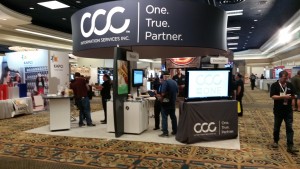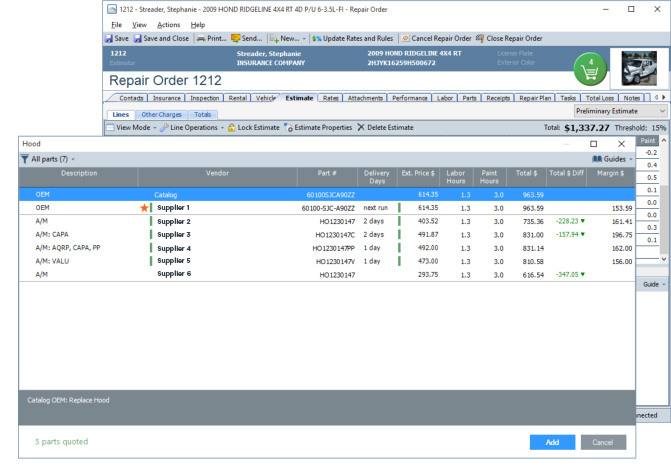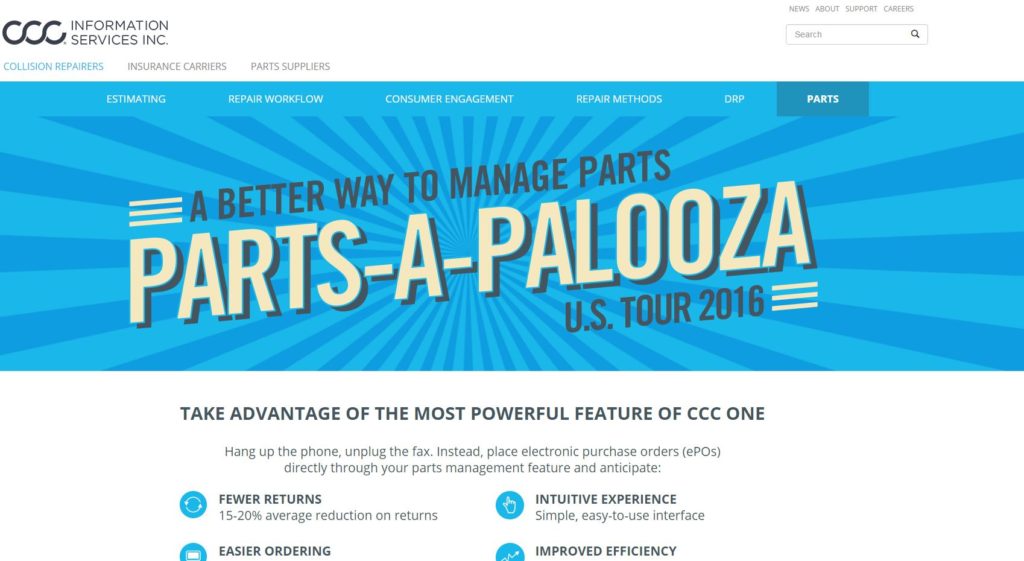
CCC reassures Conn. auto body group as TRUE Parts system grows nationwide
By onAnnouncements | Associations | Business Practices | Insurance | Repair Operations | Technology
Responding to privacy and price erosion concerns by a state auto body trade group, CCC stressed Monday that its rapidly expanding TRUE Parts program doesn’t disclose margins or other key elements of parts shopping.
The Auto Body Association of Connecticut on Friday formally came out against the program, writing that the parts procurement option — at full strength in 20 of the nation’s 50-odd markets — could be “another wolf in sheep’s clothing” and “more likely harmful than helpful.”
“As we see it, the real purpose of the program is to reduce the cost of parts by pitting dealers and vendors against one another in an exchange similar to that proposed by State Farm’s PartsTrader,” ABAC wrote. “A race to the bottom, however, will only serve to enrich insurers at our expense.”
However, David Boden of CCC on Monday said there’s no bidding going on — nor is there a chance to do so. The software simply pulls in pricing and availability information automatically from a supplier’s system, just like buying a pair of sunglasses on Amazon, according to Boden.
“We enable them to transact more efficiently,” Boden said.
Essentially, the shop’s computer asks the dealer or vendor’s computer if it has the part and at what price and discount, and the seller’s software responds in kind.
“Our system calls their system,” Boden said.
Vendors don’t see each other’s price, which could fuel price erosion. “No one knows,” Boden said.
Electronic parts procurement in generally still can facilitate price erosion even if nobody’s seeing each other’s quotes if vendors, particularly OEM dealerships, are willing to deviate from list price to attract business. Selling at $95 instead of a $100 list price, for example, to differentiate oneself from the other vendors displayed on a procurement system.
But just because a supplier’s in the network doesn’t mean they can designate a price for the part. A shop selects which vendors’ prices they’ll receive, according to Boden.
An eroder (or vendor with bad quality control or delivery times) could thereby be ignored — assuming the shop isn’t on a direct repair agreement preventing such exclusions.
An insurer can’t see the different prices, nor can they see the discount given the shop, Boden said.
Both supplier and insurer confidentiality are important, as body shops and vendors have an interest in protecting business models, relationships and strategies from competitors — or insurers seeking to cut parts costs as much as possible.
“Finally, the ABAC has genuine concerns about a company collecting this much data, all of which can, and likely will, be used against us down the road,” ABAC wrote.
President Tony Ferraiolo on Friday indicated privacy was ABAC’s largest concern, acknowledging that some of ABAC’s worries would apply to any electronic parts procurement system.
“I think that’s a big part of it, the information,” said Ferraiolo, owner of A&R Body Speciality and Collision Works. He called CCC “notorious” for sharing information with insurers.
Boden on Monday also pointed to CCC’s data policy, which specifically prohibits CCC from transmitting details like discounts or margins from an insurer — “even if you ask us to.”
Regardless of whether a repair facility consents, certain types of data related to business cost and profitability will not be shared with third parties that are consumers of repair facility services, including but not limited to insurance carriers, third party administrators and fleet operators. These types of data consist of:
- projected or actual gross margin of repair;
- labor cost including employee wages, hours assigned, actual hours worked and projected or actual labor gross margin;
- actual material cost including paint/shop material units, paint/shop material cost and paint/shop material gross margin;
- repair facility internal notes;
- repair facility internal events (file history); and
- images and attachments that are tagged for internal use only.
Additionally, except as it appears in the printed estimate, parts or sublet invoice information, including quantity purchased, unit cost, invoice amount, vendor discount percentage and projected or actual parts gross margin, will not be shared with consumers of repair facility services.

Even the ancient, overly transparent EMS data standard doesn’t transmit TRUE Parts information, according to Boden. EMS transmits the estimate, but it doesn’t send parts pricing and availability or vendor discounts/shop markups, Boden said.
Essentially, the insurer (and basically anyone else with a data pump, according to CIECA), sees only the price the shop charges for the part on the estimate — nothing about the process before, according to Boden.
“It just says what the estimate says,” Boden said.
Boden last year described the system as more efficient, as there was no need to leave the estimating system to order parts, and invoices were sent through CCC — which meant no more reconciling supplier prices with an estimate. CCC also noticed a surprising number of parts being ordered after normal business hours, something less efficient or in some cases impossible with “call and fax.”
“From our vantage point, however, any potential efficiency created by the TRUE Parts Network is easily outweighed by the longer term costs on the industry,” ABAC wrote.
The system is ramping up dramatically, and Boden agreed that an expansion into Connecticut probably prompted the concern. He said he wished ABAC had reached out to CCC first for more information.
Last fall, the procurement system expanded to desktops, which most repairers use. While an aftermarket network had been developed over the few years of the program’s existence, CCC at that point only had four out of the nation’s 50-odd markets represented by dealers, according to Boden.
Today, the vast majority of aftermarket vendors are on the True Parts system — “The last couple big ones will be on very soon,” Boden said — and while recyclers haven’t been available as long, there’s “pretty much national coverage.”
But OEM parts still make up the bulk of components used in repair, and without dealers to sell them to CCC users, the system would demand a user leave the IP and use a different means of securing those parts.
ABAC had challenged the program on that point too, calling True Parts “redundant” given services like Collision Link, Auto Parts Bridge and Opstrax V2, “all of which not only do the same thing, but need to be used with specific O.E.M. Auto manufacturers.”
However, CCC has expanded its dealer presence to 20 of the 50 markets since October.
“We’re going hard to the rest now,” Boden said. “… Then we start filling in holes.”

Vendors pay CCC under a complex pricing system that includes factors like sales percentages and one-time setup fees but is tempered with caps.
“Dealers are saying it’s well worth it,” Boden said.
Mandate
Unlike systems like PartsTrader (State Farm) and Solera’s APU (American Family), no insurers are mandating direct repair program shops use CCC TRUE Parts, Boden and Ferraiolo agreed.
Some insurers do require DRP shops use CCC as an estimating service, but the actual parts shopping element is up to the shop. They can use the feature or ignore it, Boden said.
Of course, there’s nothing stopping an insurer and its DRP shops entering into a contract agreeing to the use of TRUE Parts, but the same could be said of any electronic parts procurement system — or even some hypothetical “call and fax” methodology.
“I think our program’s good for the industry,” said Boden, who said he wished ABAC had contacted CCC for more information. “… We don’t want to get lumped in with everybody as one big thing.”
More information:
“CCC’s TRUE Parts Network is bad for this industry.”
Auto Body Association of Connecticut, May 5, 2016
CCC TRUE Parts “Parts-A-Palooza 2016” page
Images:
The CCC booth at SEMA 2015. (John Huetter/Repairer Driven News)
In October, CCC announced live parts pricing already available for tablet users would come to the desktop version of CCC ONE. Most collision repairers use the desktop edition. (Provided by CCC)
CCC hypes its TRUE Parts Network in this screen promoting its “Parts-A-Palooza U.S. Tour 2016.” (Screenshot from www.cccis.com)

